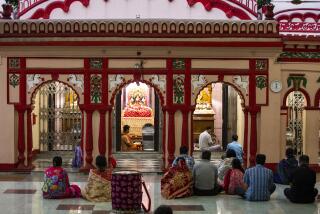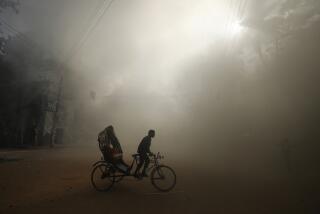Bangladesh building collapse unlikely to spur reform, experts say

- Share via
NEW DELHI — A clothing factory in an emerging country collapses or catches fire with horrific loss of life. Famous Western brands are found in the wreckage. An investigation reveals substandard practices in the local and global clothing trade.
There was a distinct feeling of deja vu Thursday as rescuers worked desperately through the night at the site of a collapsed building in Bangladesh, crafting makeshift escape chutes from bolts of fabric.
The hand-wringing, finger-pointing and promises of reform started hours after the nine-story Rana Plaza building pancaked Wednesday morning just outside the nation’s capital, Dhaka, killing at least 238 people, most of them apparel workers, and injuring more than 1,000. Local news media reported that workers had noticed large cracks in the building Tuesday but were ordered back to their sewing machines.
For once, political turmoil in Bangladesh proved a blessing. A general strike called by the opposition Wednesday left most shops on the bottom two floors closed even as apparel factories on top continued operating.
“We were lucky; it could have been much worse,” said Mohammad Alimullah Miyan, a disaster management specialist and vice chancellor of Dhaka’s International University of Business Agriculture and Technology. “But people are very angry.”
Other garment factories closed Thursday after workers threatened to sabotage equipment unless the premises were shuttered in sympathy, and more than 20,000 laborers blocked the Dhaka-Narayanganj highway.
Despite the horrific scenes, labor, business and disaster experts say dramatic change in the Bangladeshi or global clothing industries is unlikely any time soon. They point to corruption, desperation, vested interests and Western consumers who favor better working conditions but balk at paying more for their T-shirts, especially when their own jobs are vulnerable.
“This is the latest terrible demonstration of the race to the bottom,” said Jyrki Raina, general secretary of the IndustriAll Global Union, a Switzerland-based labor group. “International brands go to the cheapest production country, currently Bangladesh.”
Raina acknowledged that his teenage daughter, despite having a labor activist in the family, favors cheap clothes.
Reports, based on records found in the wreckage and on supplier websites, linked garments made in the building’s multiple factories to such companies as Wal-Mart, Benetton, Spain’s Mango and the Irish chain Primark. Wal-Mart said it was investigating to determine whether it had used one of the factories; Primark, calling the tragedy “appalling,” confirmed that it was a buyer; Benetton told the Associated Press that no one involved in the collapse was a Benetton supplier; and Mango said it had only been in discussion with a supplier in the building to produce a test sample.
Western labor unions for decades have targeted and shamed Nike, Wal-Mart, Gap and other publicity-conscious brands in their drive for better work practices. Some critics argue that labor groups aim to protect members’ jobs at least as much as to help foreign workers, a contention Raina disputes.
The pressure has led to some changes. Larger retailers have adopted codes of conduct and hired auditing firms to inspect factories. Although many are sincere, others walk a fine line, hoping to appear conscientious without sacrificing profits.
But policing the industry can resemble a whack-a-mole game. “More,” “faster,” “cheaper,” “better” are mantras in an ever-shifting landscape of sharp-elbowed labor brokers, interchangeable subcontractors and fleet-footed contractors willing to switch countries or companies for pennies per piece. And at the top of the competitive heap are retailers bowing and scraping to consumers with bargains in their eyes.
“The global textile and clothing industry is very footloose,” said Rajiv Biswas, Asia-Pacific chief economist with IHS Global Insight, a financial information firm. “So low-cost textile manufacturers face considerable pressures to keep costs low and maintain global competitiveness.”
For poor countries, the industry promises a first step up the development ladder, a path forged by Japan, Taiwan and Hong Kong. Pitifully low wages — minimum wage is about $37 a month in Bangladesh — by Western standards are often decent by local standards.
And cutting safety corners is sometimes seen as the unfortunate price of a national development strategy. More than 700 Bangladeshi textile and apparel industry workers have died over the last decade in fires and building collapses, according to the Bangladesh Institute of Labor Studies.
Bangladesh’s $20-billion apparel export industry has grown rapidly — it’s now the world’s second largest, after China — accounting for 80% of the nation’s exports. This gives factory owners significant clout in sidestepping onerous work and safety rules, with more than two dozen apparel makers now serving as lawmakers. “And at least one government minister is a factory owner,” Raina said. “As everybody says, there are vested interests.”
On other fronts, corrupt building inspectors can easily develop “temporary blindness” for a few dollars, industry analysts said, even as bureaucrats balk at upsetting the golden job goose in a country of rampant poverty, unemployment and squalor.
“Generally we don’t have a good reputation on corruption issues,” said Miyan, who favors a national fund to boost inspections, training and public awareness. “In some of our rules, there is too much discretion, which gives [officials] opportunities.”
The latest Bangladeshi factory collapse, the worst garment disaster in the country’s history, follows a fire at Dhaka’s Tazreen Fashion late last year, which killed 112. That factory lacked emergency exits and many workers burned alive after being told it was just a fire drill.
In a filing Wednesday to the U.S. Trade Representative’s Office on retaining preferential access to U.S. markets, Bangladesh promised stricter oversight but revealed that it has just 183 inspectors on paper — half the positions are vacant — overseeing 4,500 garment factories.
It said it was adding fire inspector teams and had set up a hotline for workers to report fire safety risks, even as it denied claims by the AFL-CIO that it was making collective bargaining difficult.
Although the worker safety picture in Bangladesh remains bleak, experts said, each disaster increases the pressure, at least incrementally, to reform or risk losing scandal-wary global customers. “Creating real change will take years,” Raina said. “There’s no way you can fix this immediately.”
Tanvi Sharma in The Times’ New Delhi bureau and Times staff writer Emily Alpert in Los Angeles contributed to this report.
More to Read
Sign up for Essential California
The most important California stories and recommendations in your inbox every morning.
You may occasionally receive promotional content from the Los Angeles Times.













